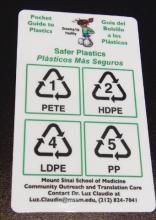SAN FRANCISCO – The principles of "risk communication" can help physicians answer parents’ questions about environmental risks to health.
Dr. Maida P. Galvez employed these principles to demonstrate how she addresses a common parental question these days: Are plastics dangerous? Whether discussing plastics or other topics, it’s helpful to craft clear and concise messages in advance using straightforward language, she said at the annual meeting of the American Academy of Pediatrics.
Develop a maximum of three key messages. For each of those messages, prepare three supporting facts, advised Dr. Galvez of Mount Sinai School of Medicine’s Center for Children’s Environmental Health and Disease Prevention Research, New York.
In the three key messages, first define the exposure to the potential environmental risk, then explain what is known about potential health effects, and finally offer action items for families, she said.
Many parents have heard of potential health risks from phthalates or bisphenol A in plastics. They may ask physicians how to tell if toys contain phthalates. Are bottles with bisphenol A harmful? What health effects should they look for? What alternatives can their children use to avoid phthalates or bisphenol A?
Employing the lessons in risk communication, a physician might first define the exposure to these substances by saying that phthalates and bisphenol A are plasticizers that are added to common products because they add flexibility and durability, Dr. Galvez said.
Summarizing what is known about potential health effects, the physician might then say that concerns have been raised about the potential for health effects based on animal studies and growing evidence that the U.S. population is universally exposed to phthalates and bisphenol A.
If families want to take action, given the concerns raised by animal studies and limited human studies, they can take a precautionary approach and choose alternatives to products that may contain these plasticizers, she said.
That simple one-two-three messaging can be fleshed out with the supporting facts if there’s time and interest from the parents.
Phthalates are found in personal hygiene products like cosmetics, shampoos, fragrances, and nail polish and in food packaging, medical tubing, children’s toys, and vinyl products. Bisphenol A is found in hard plastic items like sports water bottles, baby bottles, canned foods, and dental sealants. These two plasticizers can leach from the products, exposing humans through ingestion, inhalation, or dermal absorption.
Phthalates and bisphenol A are known to have hormonal activity, and thus are often referred to as endocrine disruptors. Studies suggest that they are ubiquitous in the U.S. population, with higher exposure levels in children and adolescents than in adults.
In animal studies, exposure to these plasticizers can affect birth outcomes, especially the male reproductive tract. Human studies are assessing potential links between plasticizers and early puberty, obesity, asthma, and male infertility.
What can parents do? "Keep it simple," Dr. Galvez said. "Less is more. Especially in pregnancy, simplify your routine, and simplify the number of products you’re using."
Look for products free of phthalates and bisphenol A. If labels don’t provide the needed information, look at recycling symbols: numbers 3, 6, and 7 should be avoided, but numbers 1, 2, 4, and 5 should be okay, she said. Her institution created a 2-inch by 3.5-inch"Pocket Guide to Plastics" that physicians may want to distribute to patients. Copies can be requested by e-mailing Dr. Claudio Luz at Luz.Claudio@mssm.edu. Similar fact sheets can be downloaded from the Web site of the Pediatric Environmental Health Specialty Units.
To avoid plasticizers, don’t put plastic items in the microwave or dishwasher because heat promotes leaching. When possible, choose safer alternatives to plasticizer-containing products, such as fresh fruits and vegetables instead of canned food, breast milk instead of canned infant formulas, foods in glass containers instead of plastic, and water bottles made of stainless steel, Dr. Galvez recommended.
The antiandrogen effects of phthalates syndrome can cause hypospadias, undescended testes, fetal germ cell effects, infertility, and decreased anogenital distance, according to rodent research (Int. J. Androl. 2006;29:140-7).
Bisphenol A is a weak estrogen, and in animal studies has been linked to adverse birth outcomes, effects on the male reproductive tract, early puberty, and increased body size. Limited human studies suggest it may affect neurodevelopment or liver function and may be associated with cardiovascular disease or type 2 diabetes, she said.
Dr. Galvez said that she has no pertinent conflicts of interest.


